
views
- Visit your DMV’s website to request a replacement title. Fill out the replacement form and bring it to the DMV.
- Then, create a bill of sale that lists the vehicle's year, make, model, sale price, and VIN. Fill out the transfer section on the back of your title to finish the sale.
- If your car is older and title-exempt in your state of residence, like Vermont, fill out your state’s bill of sale and title exempt form.
Applying for a New Title

Replace your title before negotiating a sale, if possible. If you haven't already listed your car for sale, replace your title before doing so. Selling a non-exempt vehicle without a title is a ticketable offense or misdemeanor. Some states require you to hold a title for 30 days before transferring ownership. Many states don't title vehicles that are at least 15 or 25 years old. This is called a title exemption. If your vehicle is title-exempt, you'll just need a bill of sale to transfer ownership. If your car doesn’t have a title already, submit a DMV form and pay the allotted fees.
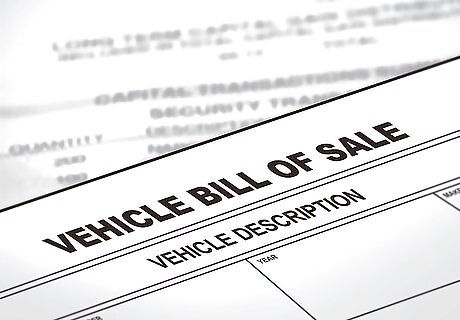
Provide proof of ownership if you never titled the vehicle. If you never had a title and never registered your vehicle, you'll need to track down your original bill of sale. If you don't have a bill of sale, check which documents your state accepts as valid proof of ownership. When you apply for a new title, you'll need to provide any necessary documentation and fill out an affidavit attesting that you're the owner of the vehicle. Your state might also require you to provide proof that the vehicle is in good working order. If so, you'll need a certificate of inspection from a state-approved inspector.
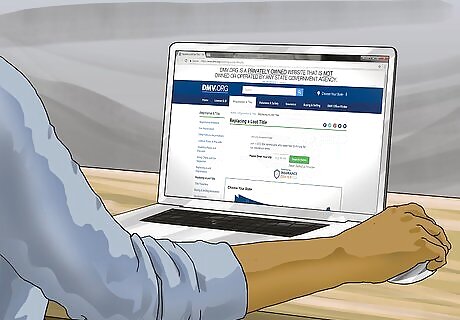
Go to the title replacement page on your state's DMV website. The process of requesting a duplicate title varies slightly by state. Visit your local DMV (Department of Motor Vehicles) website to find out specific information about your state's procedures. Locate information about your state's title replacement process here: https://www.dmv.org/replacing-a-lost-title.php.

See if your state can transfer ownership without a title. Some states allow buyers to request a temporary permit that allows them to operate a vehicle while waiting for a duplicate title. In other states, the seller fills out a transfer of ownership form. This allows the new owner to take possession of the vehicle before the new title arrives. You'll still need to apply for a duplicate title. A transfer of ownership form just allows the new owner to operate the vehicle before the new title arrives.
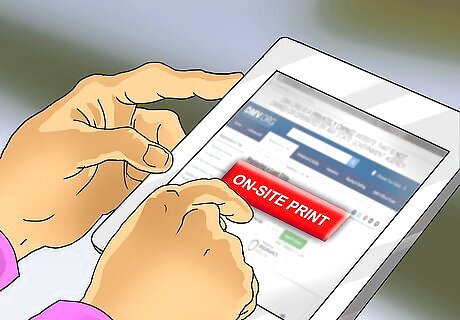
Find out if your state offers express services. In some states, you can pay extra to have your title printed immediately. Otherwise, your title will arrive in the mail at least 1 to 2 weeks after submitting your replacement form. Check your state's DMV site to see if they offer on-site printing.
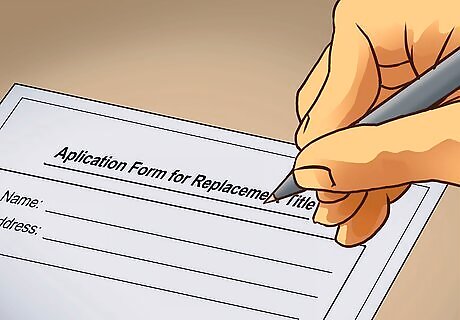
Fill out a duplicate title request form. The title replacement page on your DMV's website will provide a link to a title replacement form. You can fill out the form at home, print it, and bring it to the DMV. Alternatively, you could just go to the DMV and fill it out there.
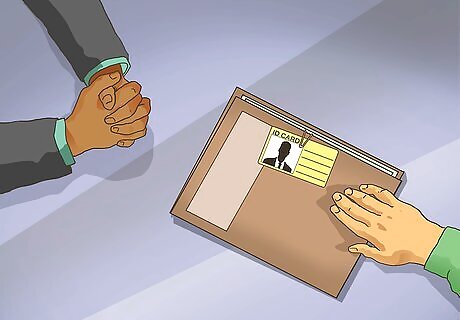
Bring your ID, registration, VIN, and other required information to the DMV. Before making the trip to the DMV, double check the list of documents you'll need to bring. Your state might require you to provide a pencil rubbing or photograph of the VIN, or vehicle identification number. It's typically located on the driver's side dashboard. You might also have to fill out an odometer disclosure form. Some states only require this for vehicles 10 years old or newer.

Pay the duplicate title fee. After submitting the form and required documents, you'll have to pay for your title copy. Fees range between $10 and $80 USD and vary by state and vehicle type. If you request an express title or have it printed on-site, you'll need to pay an additional fee. Your state's DMV website will list the duplicate title fee.
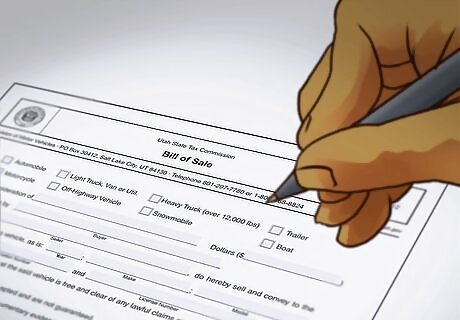
Create a bill of sale. If you haven't already, write a bill of sale that lists the vehicle's year, make, model, sale price, and VIN. Include the date of sale and the names, addresses, and signatures of both buyer and seller. Provide the buyer with the bill of sale, and keep a copy for your records. Your state's DMV might have a template bill of sale, which will help ensure you include all necessary information. You can find a sample bill of sale here: https://tax.utah.gov/forms/current/tc-843.pdf.

Complete the transfer section on the back of the title. You can transfer the title once you've received the replacement copy. Fill out your name, the buyer's name, and vehicle mileage in the appropriate fields. Sign it, then give it and a bill of sale to the new owner. Some states also require the price to be listed on the title.
Selling a Vehicle with a Lien

Determine how much it will cost to pay off the vehicle. Contact your lender or lienholder if you're not sure how much you owe. Ideally, you'll owe less than the car's value. If you owe more than the car's value, you'll have to cover the difference between what you owe and what the buyer is willing to spend. Suppose your vehicle's fair market value is $8,000, you're selling it for $7,900 and you owe $2,500. The buyer will pay off the balance to clear the title, then pay you the remaining $5,400 in a separate transaction. If your car is worth $8,000, a buyer is willing to pay $7,900, and you owe your lender $9,000, you'll have to pay $1,100 out of pocket to clear the title.

Have your lender explain the process to the buyer if they're uneasy. Purchasing a vehicle with a lien can be confusing and might put off some buyers. It might be helpful to take them to your bank (or whichever financial organization holds your lien). Ask an employee to explain to the buyer that they'll pay the bank to fulfill the loan, then pay you the sale's remaining balance. If you're selling the car to a dealership instead of an individual, they'll handle the title clearing process. They'll contact the lender for you and handle all of the details.

Consider setting up an escrow account. If the buyer still isn't sure about completing the purchase, an escrow account would add security. While you're at the bank, ask the teller about escrow services, or set up an account online. A third party, such as a bank, oversees an escrow account. They manage the money involved in a transaction and release funds at checkpoints in the sale agreement. If a buyer wasn't satisfied with the transaction, an escrow account can guarantee that they'll get a refund. In a private transaction, they might not have that assurance.
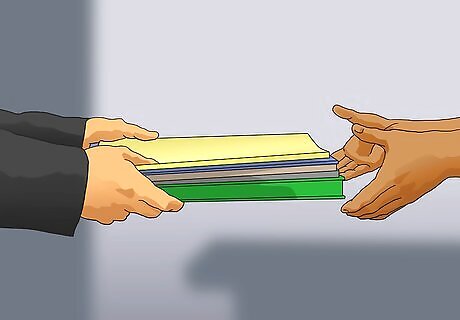
Ask the lender to provide documentation after paying off the vehicle. After the buyer pays off the balance, ask your lender for a written statement attesting that the loan has been paid in full. Keep this statement in your records.
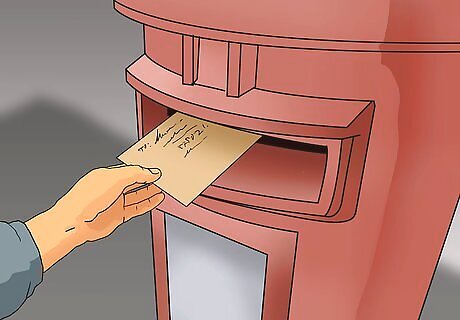
Tell the lender where to send the title after paying off the vehicle. Once the vehicle is paid off, the lender will release the title to you. If they're a local organization, they might hand the title over to you in person. If not, provide them with your mailing address.

Transfer the title to the new owner. When you have the title in hand, fill out the transfer section on the back. Then give it to the buyer, along with the bill of sale.
Selling a Title-Exempt Vehicle
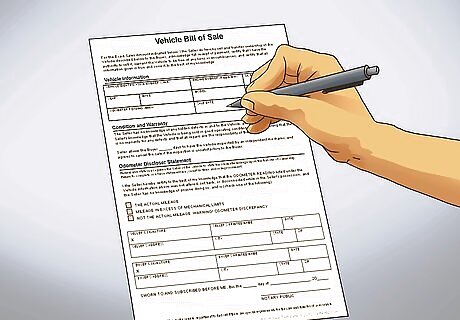
See if your state has a title-exempt bill of sale form. Some states that don't issue titles for older vehicles have standardized bill of sale forms, which buyers present when they register the car. Vermont, for example, requires the buyer and seller of a title-exempt vehicle to fill out a special bill of sale. Before selling the car, find out if your state has a required form. Create your own bill of sale if your state doesn't have a standard bill of sale form.

Notarize the bill of sale. The buyer will most likely be able to register the car with a bill of sale. While few states require a notarized bill of sale, getting it notarized will add legitimacy and might make the registration process smoother. You and the buyer will need to visit a notary public together to sign the bill of sale and have it notarized. Search online or call a local bank, parcel shipping center, or photocopy shop and ask if they have a notary public on staff.

Fill out your state's title exempt form and pay applicable fees. Procedures vary by state. You, the buyer, or both of you might be required to fill out transfer of ownership forms. In some states, the buyer can register the car with a bill of sale without any further action from you. Check your DMV's website to learn about your state's specific procedures. You might also need to provide a certificate of inspection from a state-approved inspector.

Confirm that the buyer can register the exempt vehicle if they're out of state. Things can get tricky if the buyer lives in a state that does title older cars. The bill of sale should be enough for the buyer to apply for a new title in their state, especially if it's notarized. You might also have to provide an affidavit attesting that you were the previous owner, a copy of the vehicle's registration from when you owned it, or submit other documentation to the buyer's local DMV. Before finalizing the transaction, ask the buyer to check their state's procedures for registering an untitled vehicle that's title-exempt in another state.
















Comments
0 comment